#harvey manages to recover by making the deal with his alter that
Text
For reasons I shouldn’t need to explain, one of the few things Harvey Dent and Two-Face agree on is that Fire Lord Zuko is the best character in anything ever.
For reasons I also shouldn’t need to explain, Bruce is Sokka’s biggest fan.
I now need fanart of him and reformed!Harvey in respective cosplay together. Complete with dual swords and a boomerang.
#however i also see two-face specifically relating a lot to azula and getting upset about azula hate and vilification#‘cause compared to harvey he was the ‘bad’ abused child who ‘just like his father’#two-face: i have a heart of stone#i can’t have empathy or sympathy if i’m going to deliver true justice#bruce:#…‘i was never angry with you zuko -’#two-face: (instantly crying) FUCK YOU#bruce: my first girlfriend turned out to be an assassin loyal to her megalomaniacal cult leader father#harvey: that’s rough buddy#harvey manages to recover by making the deal with his alter that#they can watch one episode of atla for every therapy session at least one of them actually engages in#so two-face stops sabotaging both his own and harvey’s recoveries to stay a villain#and by the end of the show the therapy’s worked enough that he just keeps at it#two face: come on i need to get back to crime#harvey: criminal success is like ozai’s approval you think you want it but it when you have it you feel even worse#you’ve done ‘the beach’ like five times by now#can we get to ‘nightmares and daydreams’ this time? please?#harvey dent#two-face#bruce wayne#batman#bruce and harvey#dc comics#dc#avatar the last airbender#atla#prince zuko#fire lord zuko#sokka
26 notes
·
View notes
Photo

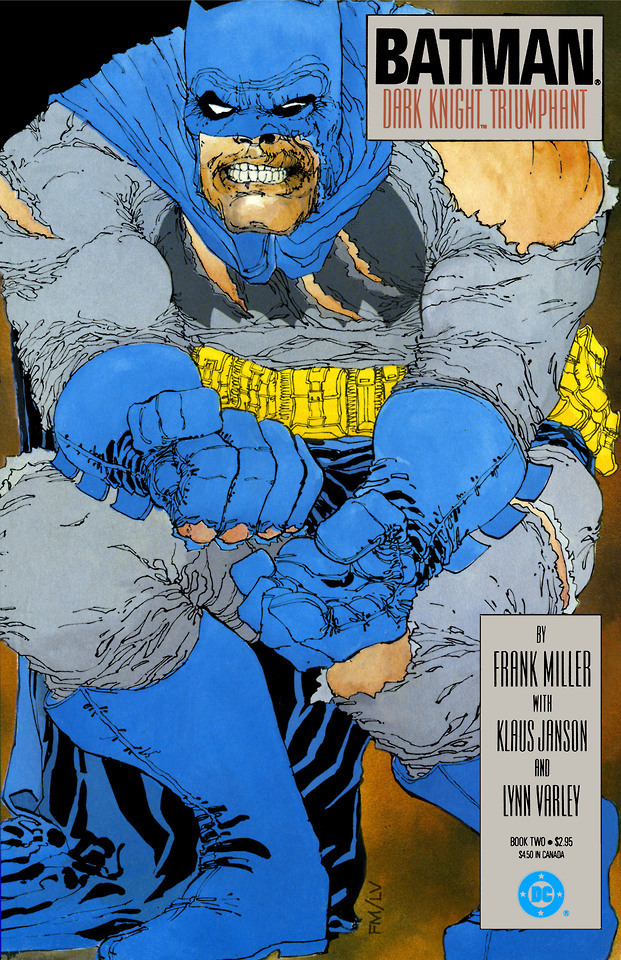
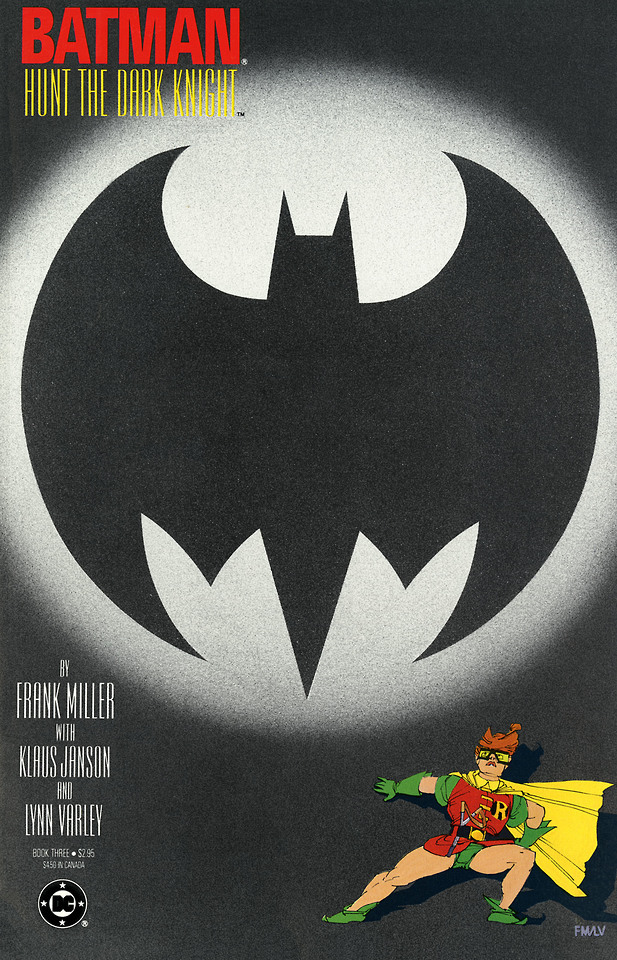
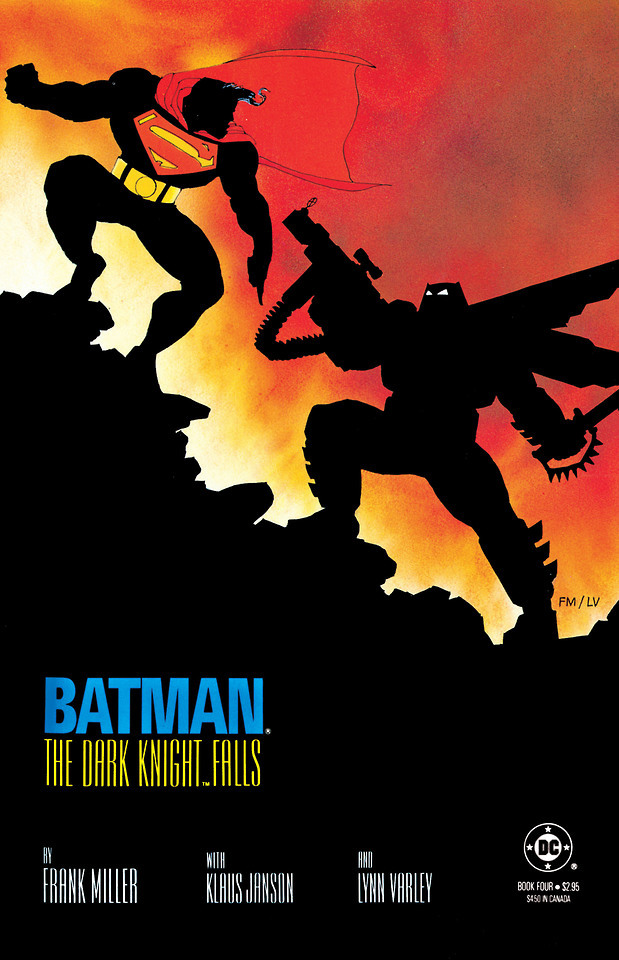
BATMAN: THE DARK KNIGHT RETURNS
JUNE - DECEMBER 1986
BY FRANK MILLER, KLAUS JANSON AND LYNN VARLEY

SYNOPSIS (FROM DC DATABASE)
It is a dark, depressing world where criminals run amok in the absence of superheroes. Gotham City is terrorized by a gang of vicious and aimless teenage murderers, the Mutants. A now 55-year-old Bruce Wayne has been retired for ten years following the death of the second Robin, Jason Todd. Attempting to bury his guilt over Jason's death, Wayne has turned to alcoholism, near-suicidal recreational activities, and has funded the rehabilitation of Two-Face in an attempt to prove to the world - and to himself - that a man's demons can be truly exorcised. On the eve of Commissioner Gordon's forced retirement, however, two events push Wayne to reestablish the presence of his alter ego: a major crime wave hits the city, and Two-Face's rehabilitation goes awry. An enormous bat crashes through the windows of Wayne Manor, symbolizing the psychological return.

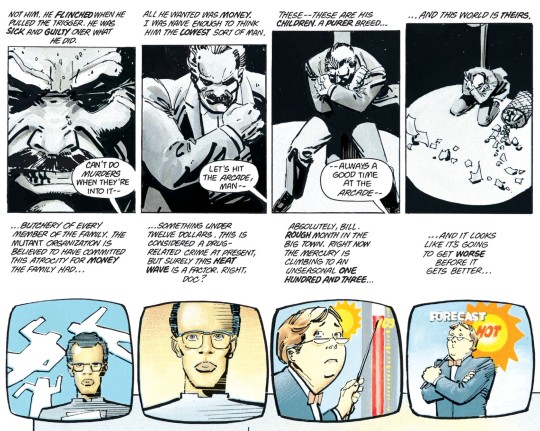
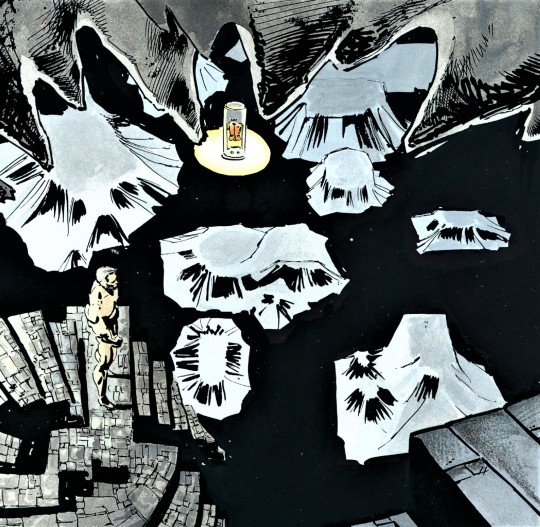
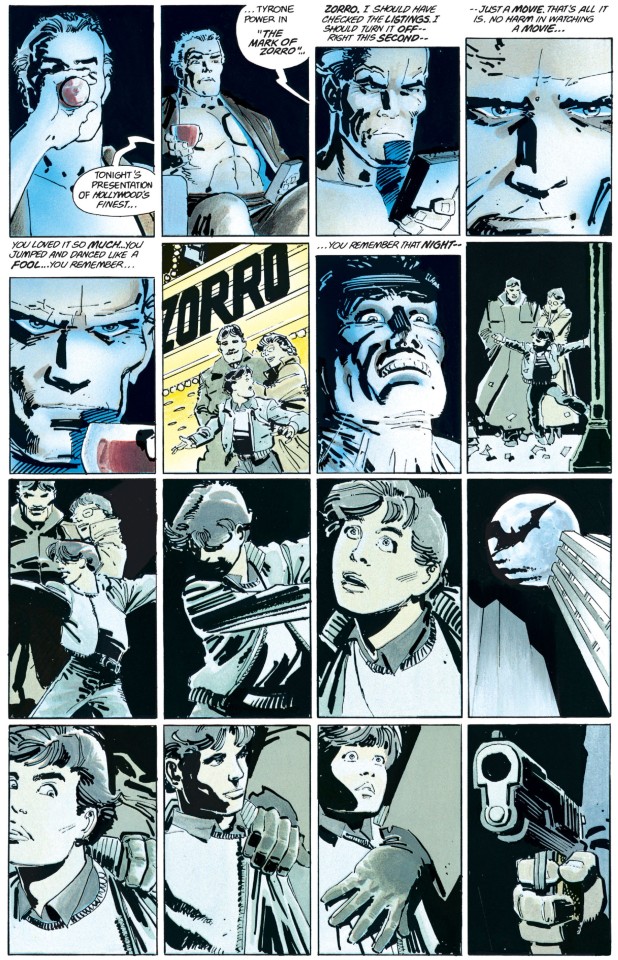
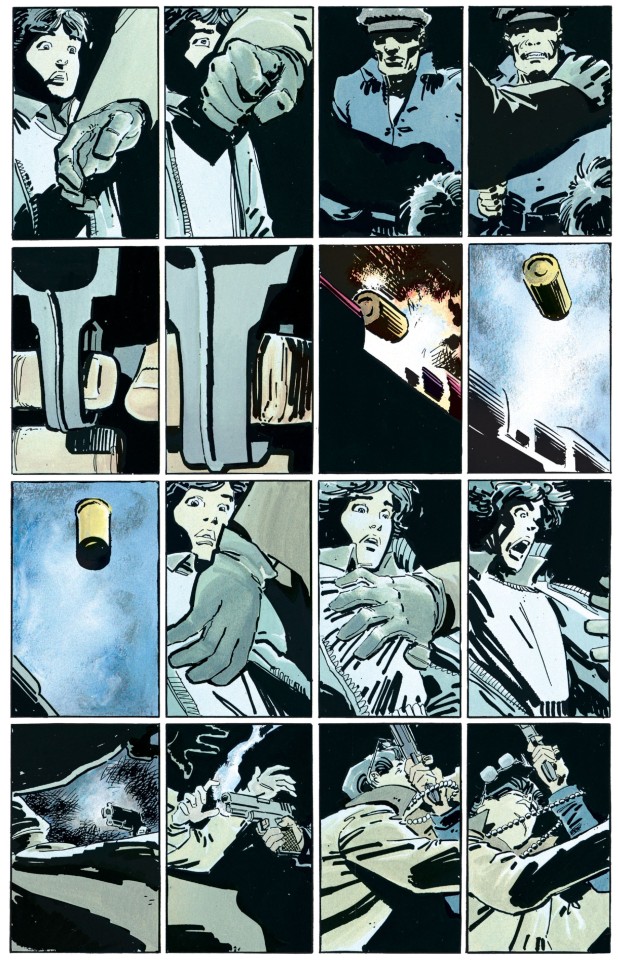
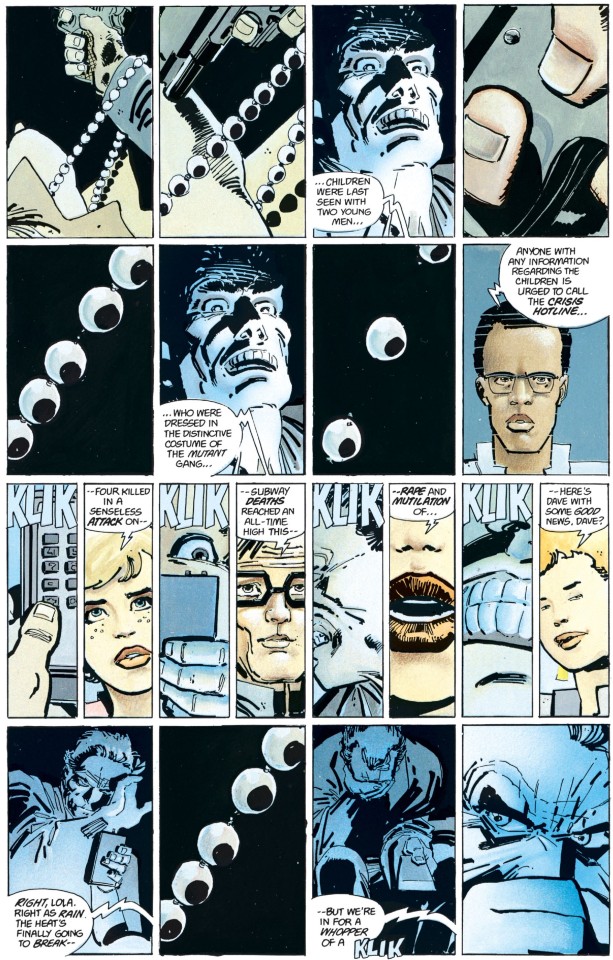

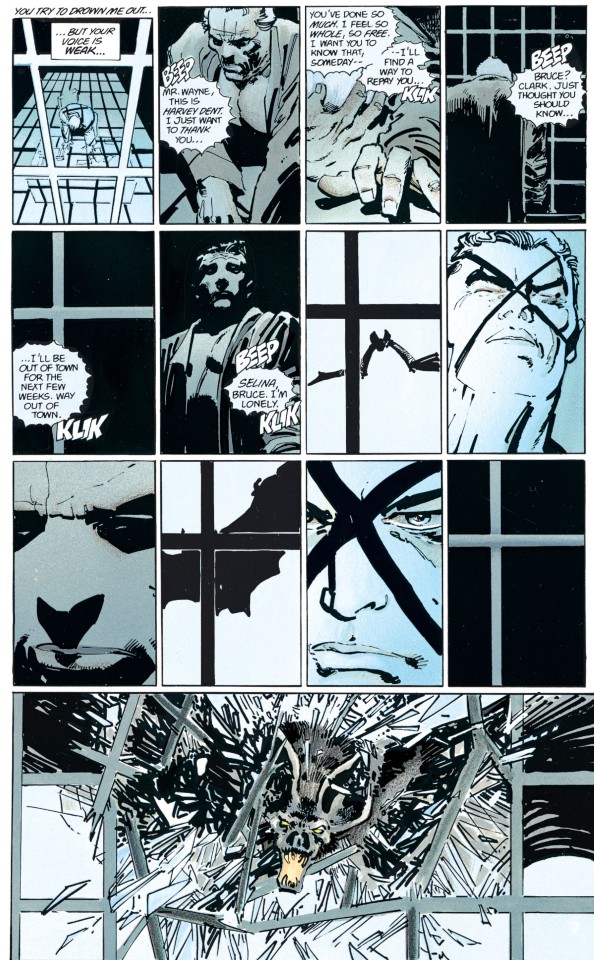
Re-donning the cape and cowl, Batman must deal with a world where even the petty criminals are homicidal maniacs who kill for thrills. He no longer has the absolute support of the police, public, or government. Reporters and psychologists see the Joker as a victim and Batman as the madman.
Batman has changed since he last put on the cape: though still quite strong and up to the physical task of apprehending ordinary criminals, Wayne is forced to acknowledge to himself that his advanced age and long period of inactivity have diminished both his skills and his ability to withstand and recover from injury. And, unknown to anyone, the Joker has likewise emerged from retirement. Catatonic and without his trademark evil grin in Arkham Asylum for the ten years of Batman's absence, the Clown Prince of Crime reawakens to his twisted, hateful obsession of the Dark Knight, upon hearing a television report about Batman's return.

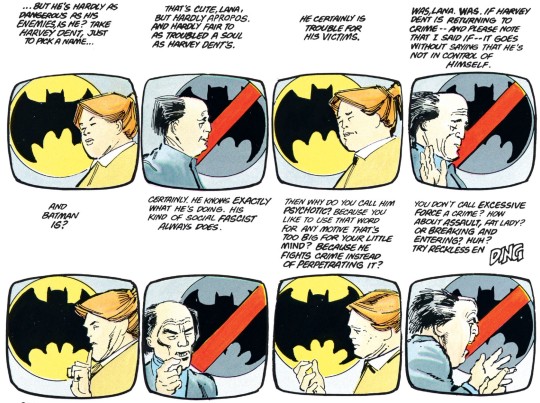
Upon Batman's return, journalists, experts, politicians and the public debate the rights and wrongs of Batman's methods and influence: some like Lana Lang praise him for reclaiming the streets from the criminals, while others criticize him for not observing the civil rights of these same criminals.
Finally, an out-of-control, nearly suicidal Two-Face threatens to blow up Gotham's Twin Towers; however Batman is able to deduce and foil the scheme. In their struggle, Batman removes the bandages that have been covering Dent's face, expecting to find Two-Face's visage split in its classic dichotomy. Instead, he sees Dent whole and handsome on the outside, but fully lost within his own mind. In Dent, Batman sees a "reflection": just as the restoration of Harvey's face led to the final destruction of his sanity, the Batman persona has become all the stronger for having lain hidden under Bruce Wayne for a decade.
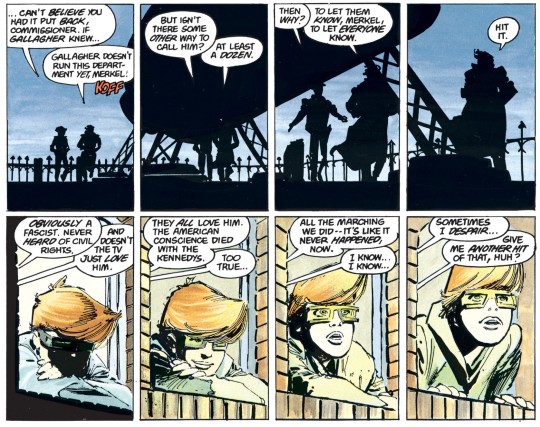
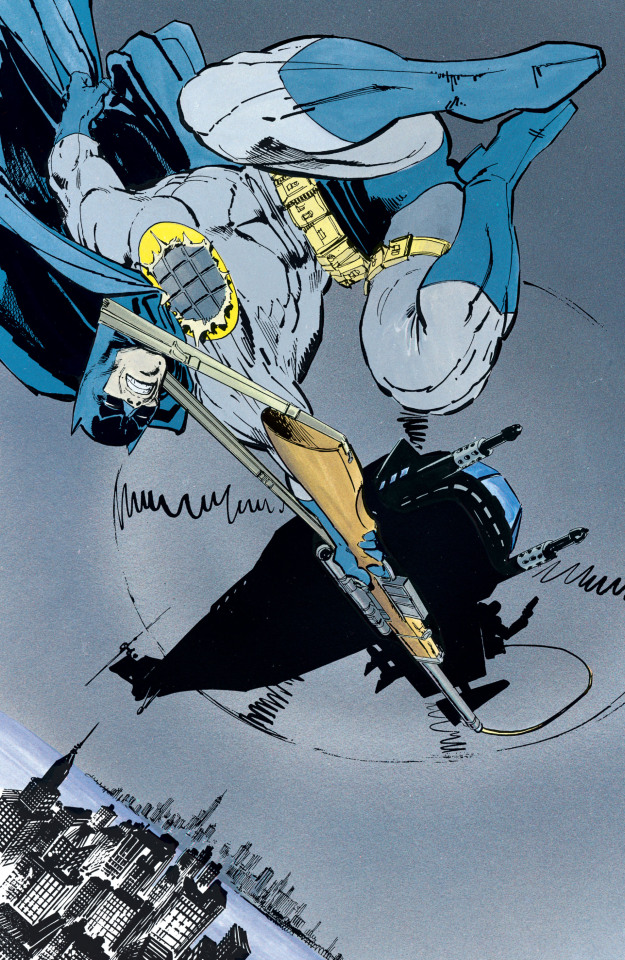
Batman struggles against Gotham's newest criminal threat, the vicious Mutant gang and their anonymous leader. As he walks to work, contemplating his upcoming retirement, Jim Gordon is almost killed by a 17-year old boy with an M60. In the course of rescuing a young child, Batman discovers that a cash-broke Army general and war hero has been arming the Mutants, in return for the money to help his sick wife. When Batman confronts him, the General commits suicide. Meanwhile, the Mayor has appointed a qualified woman as Gordon's successor, Ellen Yindel, who worships Gordon but despises vigilantes. And a young girl who owes her life to Batman, Carrie Kelley, decides to seek out her hero and takes on the role of Robin.
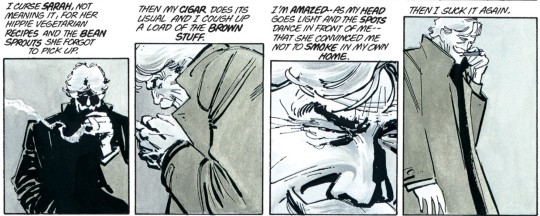

Following his leads, the Caped Crusader succeeds in tracking down the Mutant lair and defeating them with the monster Batmobile, an armored supertank rebuilt by Batman during riots ten years ago, with large cannons and machine guns that only fire rubber bullets. In a brutal hand-to-hand fight, Batman is defeated and almost killed by the Mutant Leader, as the aging Caped Crusader tries to prove to himself and Alfred that he is a force at any age. Luckily, Carrie, in her new Robin costume, has been following Batman, and manages to save him.
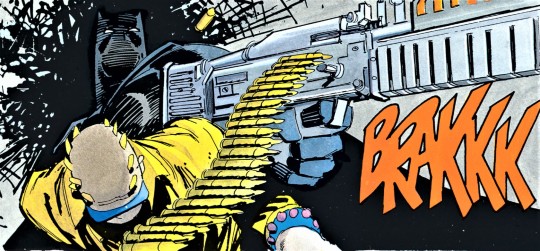
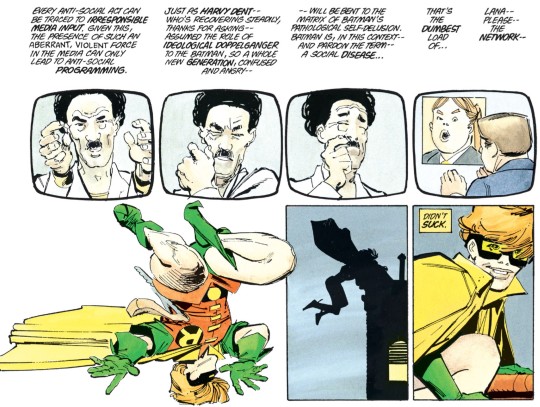
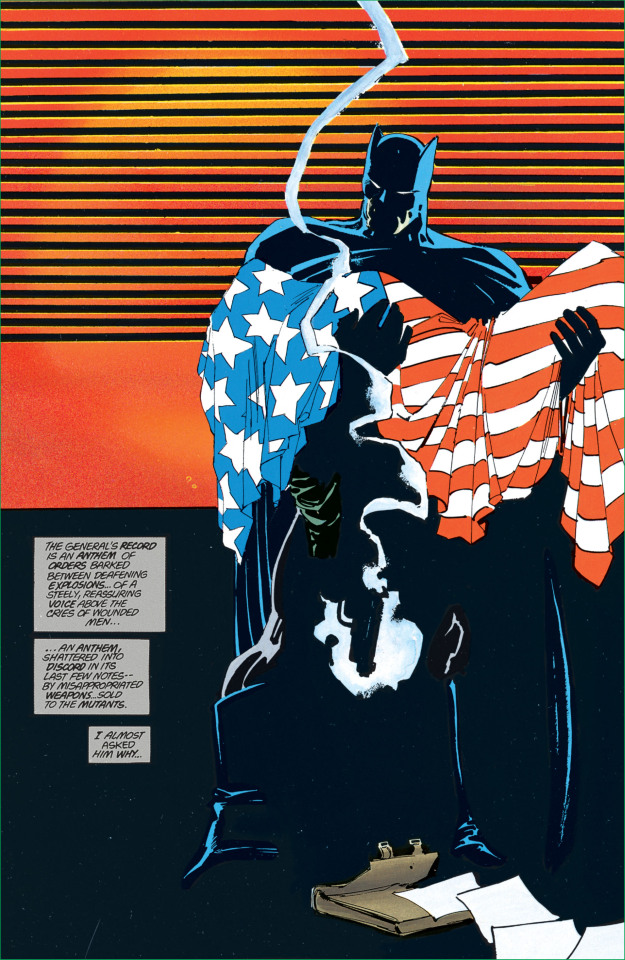

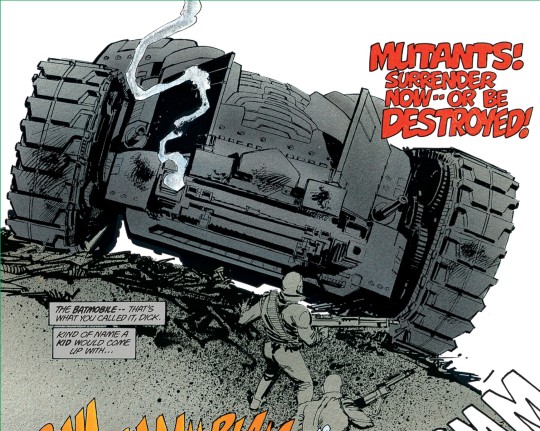
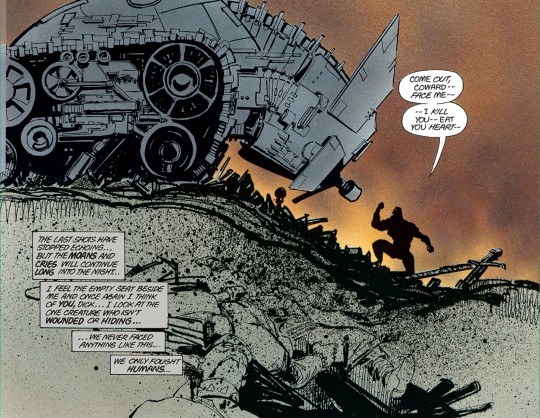
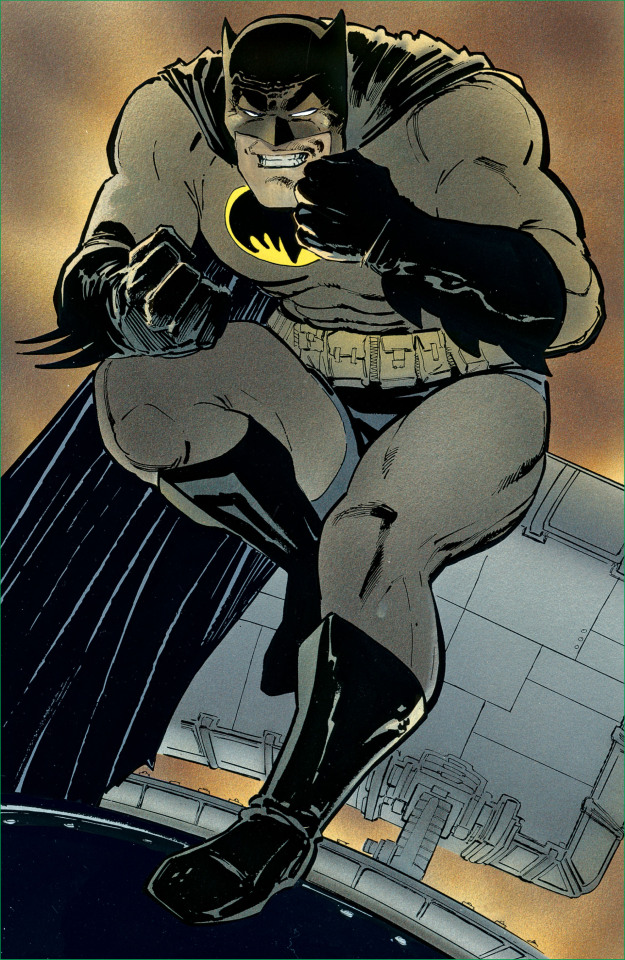
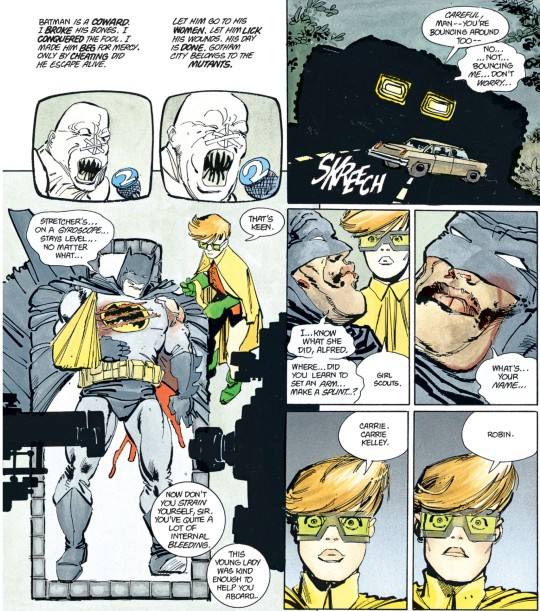
Batman returns to the Batcave where Alfred tends his wounds and argues with him over the danger to Carrie; meanwhile, the Mutant Leader is brought into custody. The Leader's absolute animalistic nature is fully revealed when the Leader manages to tear out the Mayor's throat while in custody. Gordon and Batman conspire to defeat the Mutants psychologically by staging a fight between Batman and the Leader in front of the whole Mutant gang. Using his greater experience and his environment, Batman cripples the Mutant Leader in full view of his followers. While many of the Mutants are arrested, many more now latch on to Batman as their role model, dubbing themselves the "Sons of Batman." However, their interpretation of Batman's quest will leave much to be desired.
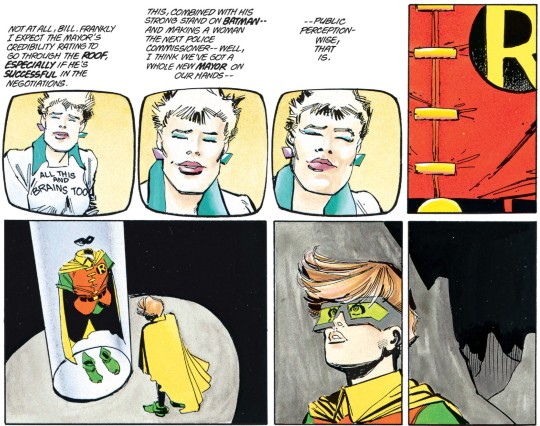
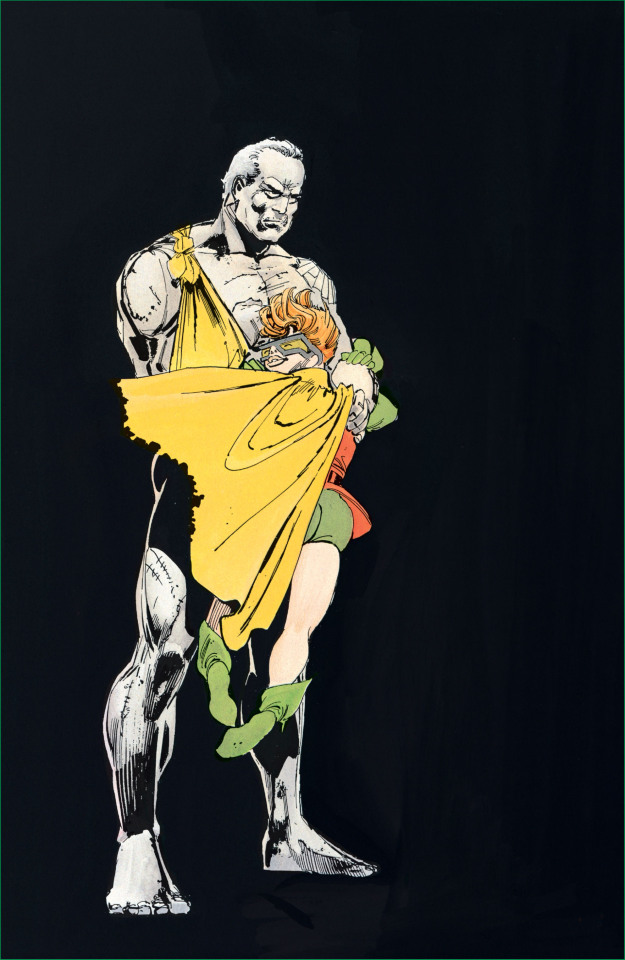
Finally, James Gordon looks forward to his retirement from the madness of Gotham and regretting the predicament that Batman will find himself in: caught between criminals and the police.
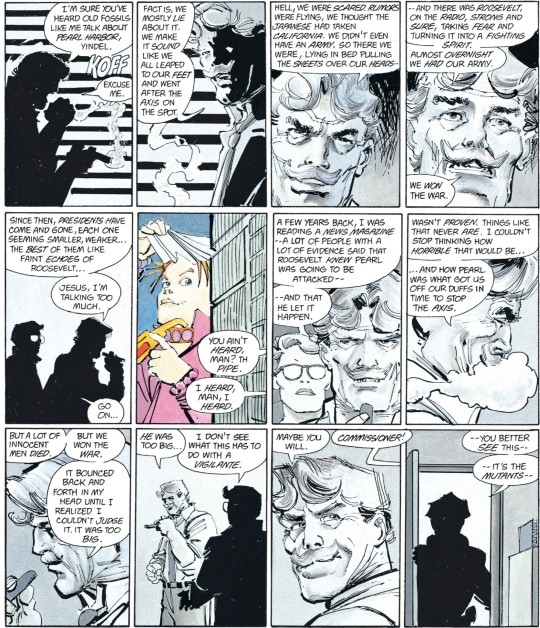
Newly awakened from his catatonia, the Joker has been slowly returning to his mad schemes while still incarcerated. He convinces his psychiatrist, the fame-seeking and Batman-hating Dr. Bartholomew Wolper, that he is not only sane but regretful. Seeking to discredit Batman, Wolper intends to exhibit the Joker on a late-night show in order to "prove" that the Joker is actually a victim of Batman's own "psychosis". Not pleased with this turn of events, Yindel places a heavy guard on the building. However, she still sees the primary threat as Batman and intends to arrest him if he appears. As the police are occupied with attacking Batman, the Joker murders everyone in the studio with his "smile gas" and escapes. Batman follows him to Selina Kyle's, where the former Catwoman has become a depressed, alcoholic and overweight madame. The Joker uses two of her girls to drive local politicians to suicide. He then beats and dresses Selina Kyle up as Wonder Woman, leaving a clear clue for Batman to follow.
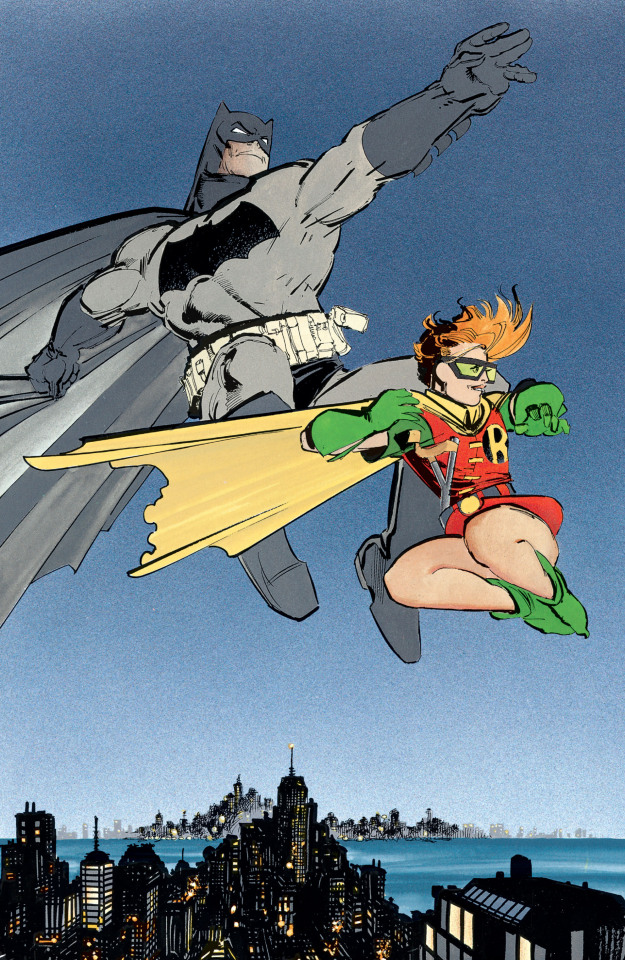
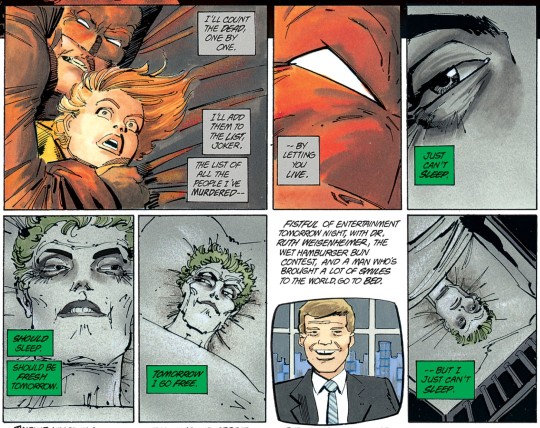

When the police burst into Selina's flat, Batman and Robin escape, but Yindel notices the young sidekick and adds "child endangerment" to the list of charges against Batman. But he then calls her up on her radio to say that it is up to her to rescue the Governor from another Joker threat. Yindel is left lost for words.
With the police on his heels, Batman, accompanied by Robin, tracks the Joker down to a county fair. They arrive too late to prevent the Joker from poisoning to death a group of young Cub Scouts, but Robin is dispatched to prevent the Joker's accomplice from blowing up a rollercoaster loaded with riders. Robin succeeds in getting the bomb clear of the ride on the moment of exploding, but in the fight that follows the Joker's accomplice is killed. Meanwhile, Batman pursues and defeats Joker in a bloody and violent showdown. Throughout the past days, the Batman has been preparing to do what he never could before: kill the Joker and end the cycle of meaningless deaths once and for all. But in the end, he still cannot bring himself to kill his old enemy, stopping himself before fully killing the Joker, leaving him paralyzed instead. The Joker, laughing madly, commits suicide by twisting his own broken neck, intending for the police to charge Batman with murder.
In the meantime, Superman has become an undercover agent for the American government and he travels to Gotham to persuade Batman to keep a low profile. However, tensions with the Soviet Union are reaching a head over U.S. support for a South American country named Corto Maltese, and Superman is called away to "deal with it". Also, the Sons of Batman have begun to make their presence known, taking an even more brutal - and deadly - tack towards criminals than Batman. Despite Batman's non-involvement, the actions of the "SOB's" only incenses the growing anti-Batman forces in the government and media further.
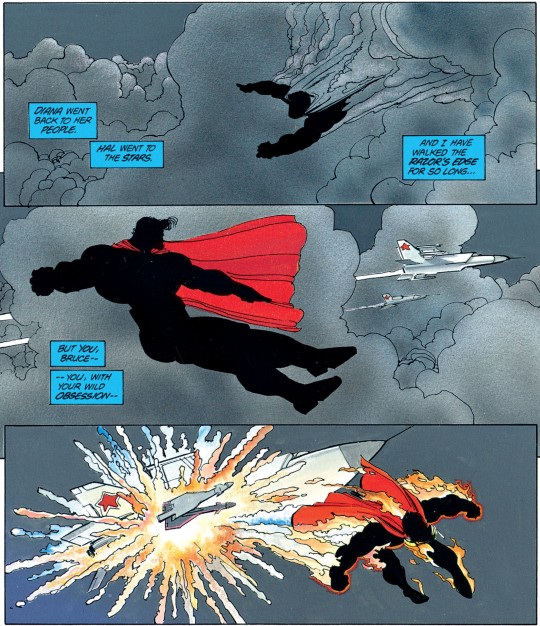
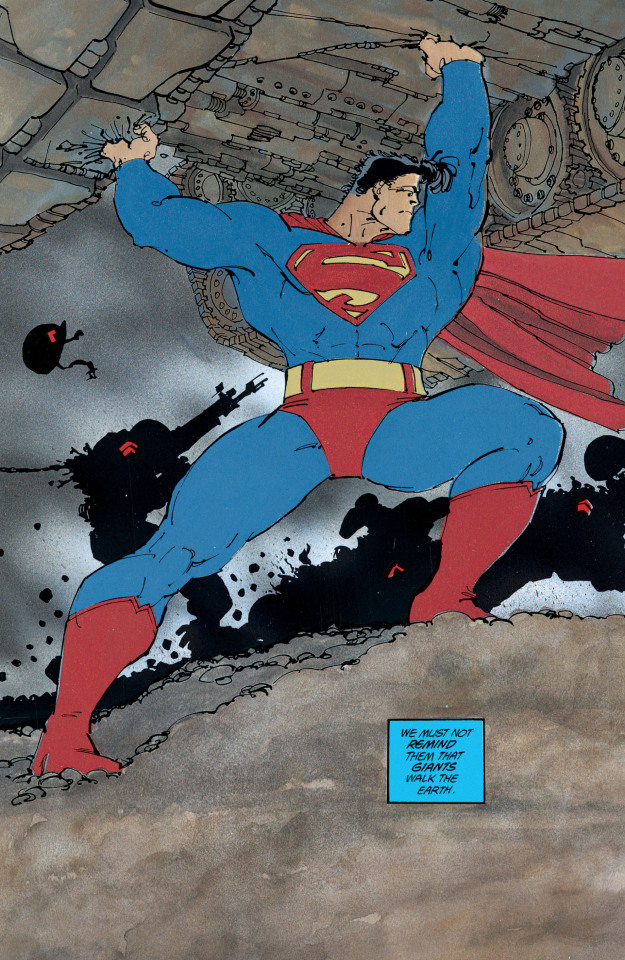

When the USSR launches a nuclear warhead called Coldbringer in response to Superman's presence in Corto Maltese. Superman manages to divert the missile to an uninhabited desert area before it detonates, but damage is done nonetheless. The warhead was designed to disrupt all electronics and communications in the Western Hemisphere as well as throw millions of tons of dust and debris into the atmosphere. Deprived of the sunlight that gives him his powers, Superman nearly dies. Gotham descends almost immediately into chaos as the blackout hits, with rioting and looting rocking the city. An airplane crippled by the electromagnetic pulse crashes into a building, feeding the panic. A few citizens, including Jim Gordon, pull together to fight the fires and retain some semblance of civilization until the power is restored.


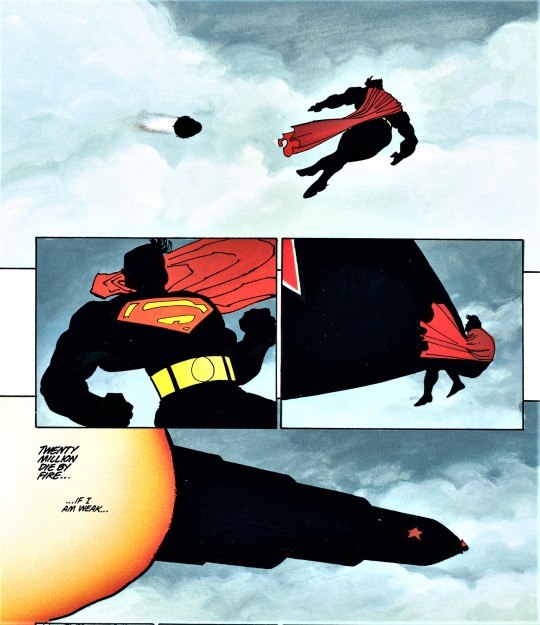
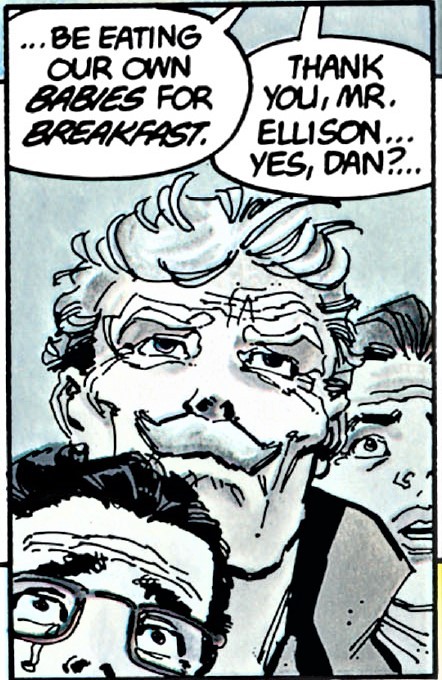


Though near death from wounds inflicted during his fight with the Joker and the police, Batman applies his ingenuity to restoring law to Gotham. He and Robin muster a force of Sons of Batman and train them in non-lethal methods as a means to stop looting and ensure the flow of needed supplies. Gotham, ironically, soon becomes the safest and best-fed city in America. Seeing this as an embarrassment rather than a blessing, the U.S. government dispatches Superman to take the Dark Knight down. Warned of their plans by Oliver Queen, the former Green Arrow who is now a bitter one-armed revolutionary, Batman prepares for his ultimate clash. Armed with an artificial powered exoskeleton, the Batmobile, synthetic kryptonite and a mysterious pill, Batman confronts Superman in a final showdown at Crime Alley, where Wayne's parents were murdered decades earlier. Batman manages to defeat the weakened Superman, only to apparently die of a heart attack at the stroke of midnight. At precisely the same moment, Alfred oversees the destruction of the Batcave and Wayne Manor, before suffering a fatal stroke immediately afterward.
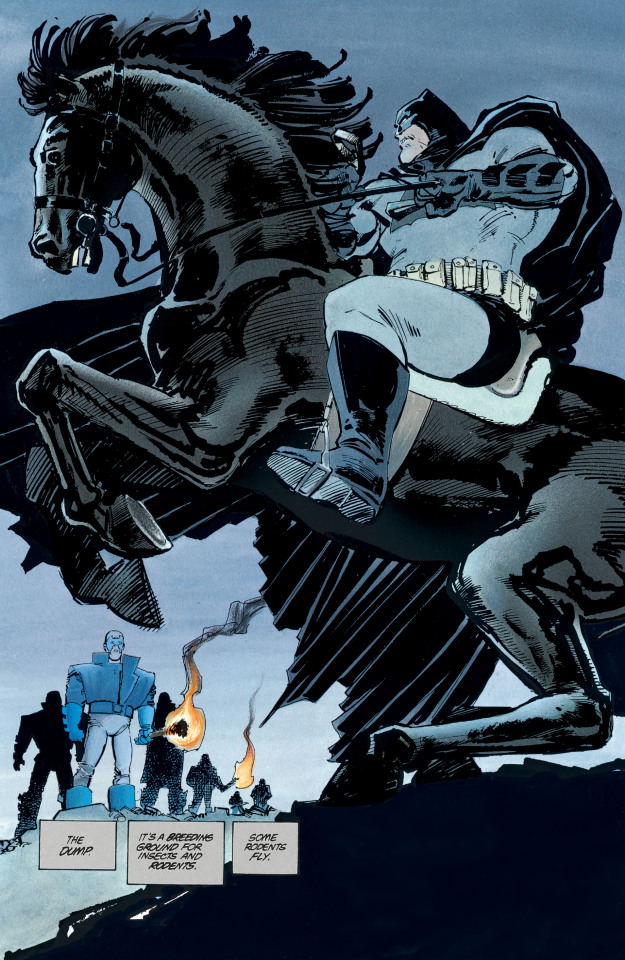


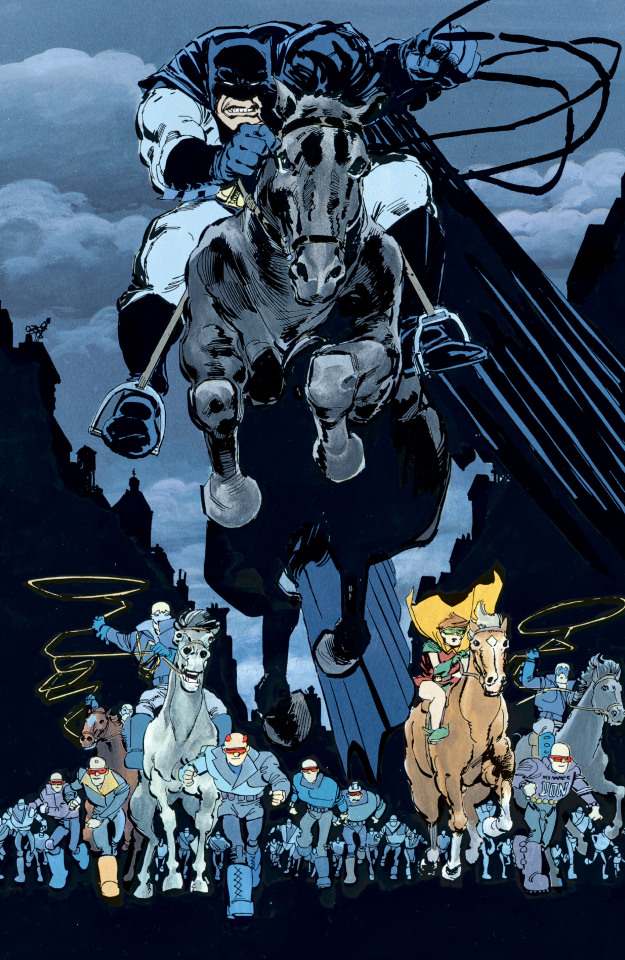

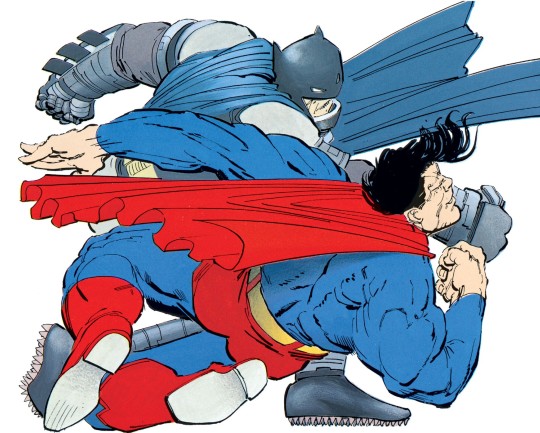
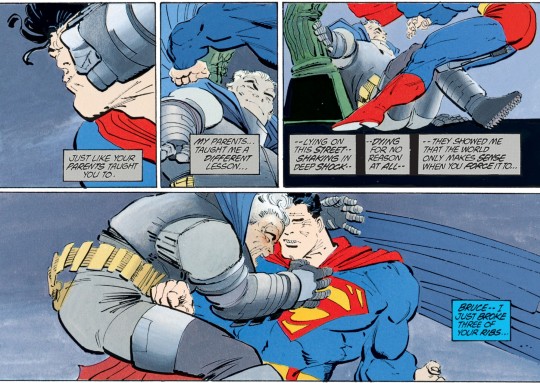
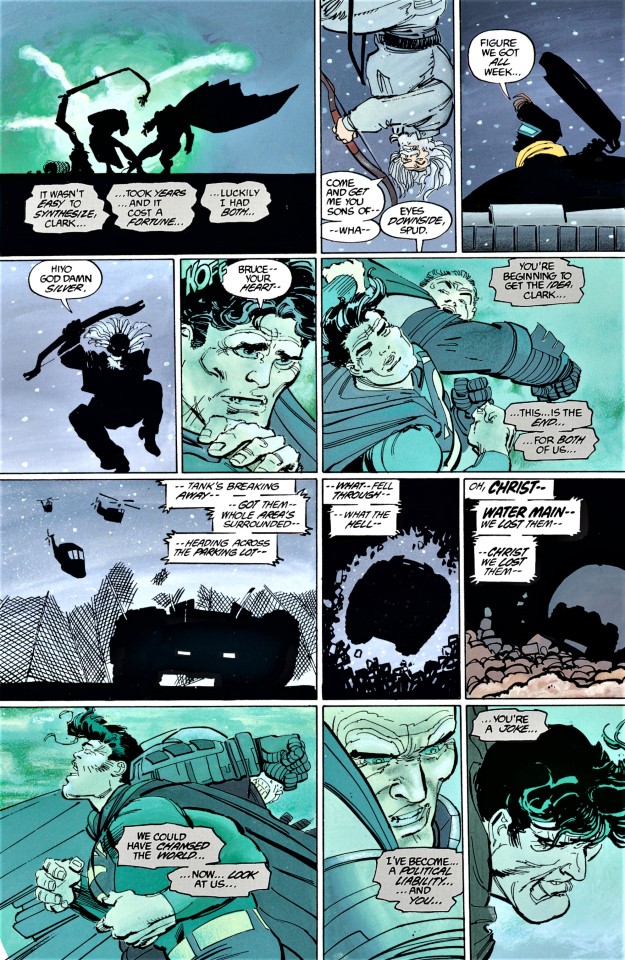
The news that Bruce Wayne was Batman spreads throughout the world; however, Wayne's stocks and funds have been sold and liquidated to his "heirs" and Wayne boardmembers, Wayne Manor and Batcave destroyed, and all evidence as to his methods and tools wiped out. At a funeral attended by Gordon, Kyle, Yindel, Carrie and others, Clark Kent is plainly ravaged with sadness and guilt. Just as he turns to leave, however, he hears a faint heartbeat coming from the interred coffin. After staring at Carrie for a few silent moments, Kent gives her a wink and leaves. Wayne has faked his death with planning, skill, and his knowledge of chemistry; Carrie digs up his living body as soon as possible. Wayne had hoped to keep the secret even from Superman; with his wink, however, Kent confirms Wayne's hope that he would play along with the charade. Bruce Wayne, finally looking forward to his life, leads Robin, Green Arrow, and his army deep into the unexplored caverns beyond the Batcave, preparing to continue his fight for justice in a more low-key, but equally important, way than in his "previous life."
FRANK MILLER IN 2006


REVIEW
I added the text because one of the characters in this story is clearly Fredric Wertham, the author of “Seduction of the Innocent” that, to me, still affects the people in power at DC Comics.
And Frank Miller.
The creation of Carrie as a Robin is not an exactly progressive move. There have been many interviews with DC writers and editors where they try to avoid answering questions about Dick Grayson as Robin, and his nature as a ward of Bruce Wayne. It’s almost as Wertham’s ghost is still haunting them with the concept that Bruce, Dick and Alfred are living a homosexual dream. I would normally think it was progress; Even when Bill Willingham made a lot of mistakes when he took on Robin, you could say that Stephanie Brown as Robin could have been progress had they not killed her off. I am also mentioning this because it will become a thing in future stories in this same universe, where Frank Miller makes fun of Dick Grayson’s “feminine side”, and Batman’s rejection of that. Like a broken couple where one of the sides decided to be straight.
But let’s talk about this story now. While I know Miller is a bit fascist sometimes, I completely understand where he was coming from when he wrote this. He was living in a world that wasn’t that different from the one in DKR. And as he said in interviews, he was mugged many times, the city was in chaos and he was watching a lot of Clint Eastwood stories.
The Dark Knight Returns could be satire, could be many things, but in essence is a western. This is not a bad thing. The Nolan trilogy is also a western. Urban westerns.
As a western it makes a lot of sense. You could also add a “Sci-Fi” to that western, but to me, it encapsulates 1986. It has everything that was an issue back then. Gangs, corruption, homophobia, racism, misogyny, the cold war, the doomsday clock, etc. And just like in westerns, Bruce Wayne feels the calling once again, to come out of his retirement to save his city.
Miller is also drawing and the composition of the pages is sometimes genius. You can see themes in the sequences even when they are not connected, and even more, the use of Lynn Varley’s colors is also an integral part of this book. There is a black and white version of this story, while it looks a bit more like other Frank Miller’s creations, I think Lynn Varley adds an important layer to this story and it feels incomplete.
Now let’s talk about Batman v Superman a bit, because the mistakes of WB are a recurring thing. After this novel was published, the modern age kicked in. Suddenly everything was grim and gritty (it was progressively becoming darker, but now it was jarring). Heroes were flawed and conflicted and violent. I think that was the wrong lesson learned from DKR. DKR is a western, it’s dystopian, it has to be violent because it’s a before-its-time-elseworld. This is not Batman, and as long as you understand that this is not canon, you will not make the mistake of thinking this is Batman. To make things even clearer, Miller went on to write Year One a year later. While that story takes a lot from DKR, it is clearly Batman. He didn’t mess with the original. To this day, Year One is the gold standard of Batman origin stories (I love Zero Year more, for different reasons). So when someone says that people need to grow up and stop complaining about Batman using lethal action. In a movie that takes heavily from DKR, you can see they didn’t understand who Batman was (or even Superman). Now, I enjoyed the extended version of that film as it really explains more about Superman and Lex Luthor, but it is very flawed in terms of story. I would say that them being violent wasn’t the main issue there, but they didn’t need to be. If people keep reading DKR as something to imitate, we will never get the Batman and Superman we love. Unless, of course, that they do an adaptation of DKR.
Speaking of, there is an adaptation of DKR and it is beautiful. It’s two animated movies, but I remember thinking they were superior to the book in terms of narrative. This was something that just didn’t work with the narrative in the Year One adaptation. What works in the page, won’t always work on the screen (perhaps Sin City being the best example of something that works well on both).
This book also introduced things to the Batman mythos, even if it isn’t canon. I do not remember now if Jason’s uniform behind a glass was a thing before this (maybe in an Earth-2 story), but it is here, and it will be in the future of Batman comics. Then we have Sarah Essen (only named Sarah here). She will eventually make it into Year One, and later brought back, you know, until No Man’s Land. The batmobile in this story looks a lot like the one in the Nolanverse, and perhaps the most influential thing coming out of this story, is the idea that Batman and Superman are too different to be friends. That lasted a long time.
In the end, you may not like Frank Miller, but his talent in this story is undeniable. Janson and Varley also make this a masterpiece. Just like the Death of Superman hooked a whole generation of comic-book readers, this story was the same hook for another generation. And they still talk about the moment they read DKR for the first time and how crazy it was for them. If you read the material at the time, they have to be right. Except for some sophisticated titles like Swamp Thing, Vigilante and Omega Men, the rest of the DCU was still trying to grow up. Well, DC was about to grow up too fast.
I give this story a score of 10.
#frank miller#lynn varley#klaus janson#dc comics#comics#review#1986#modern age#batman80#batman#the dark knight#dark knight returns#dkr#robin#carrie kelley
24 notes
·
View notes
Photo
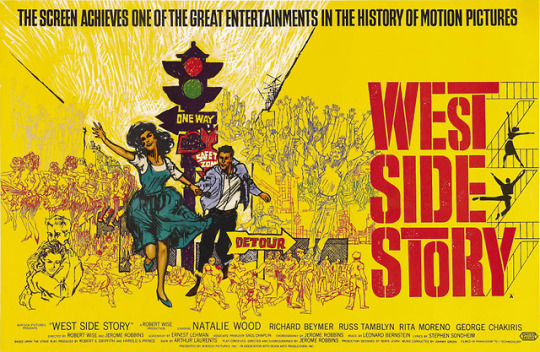
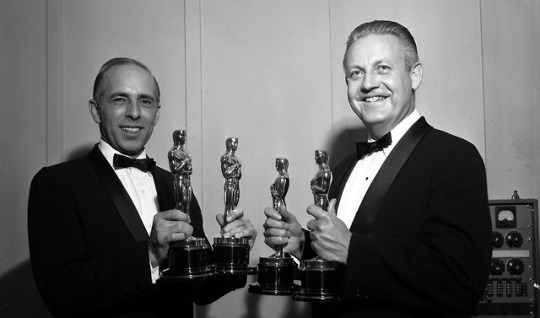
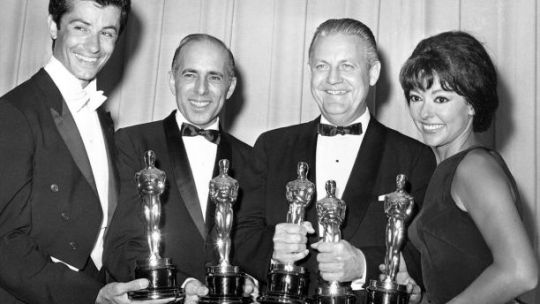


West Side Story is set in the mid 1950's, when many Puerto Ricans moved to NYC. The Jets are from Manhattan. They have ruled their "turf" for years, after defeating the Emeralds. The Sharks are from Puerto Rico. They have just recently come to NY, and want a "turf" of their own.
Who wrote West Side Story:
West Side Story is based on a conception by Jerome Robbins.
Book by Arthur Laurents
Lyrics by Stephen Sondheim
Music by Leonard Bernstein
Entire Original Production Directed and Choreographed by Jerome Robbins
Orchestrations by Leonard Bernstein with Sid Ramin and Irwin Kostal
Film Version:
Directed by: Robert Wise & Jerome Robbins
Screenplay: Ernest Lehman
Choreography: Jerome Robbins
When was West Side Story written:
Jerome Robbins' proposed the idea for writing a musical based on Romeo and Juliet to Leonard Bernstein in January of 1949 (working title: East Side Story, set in the slums at the coincidence of Easter-Passover celebrations). In August of 1955, a meeting with Arthur Laurents produced another idea -- two teen-age gangs as the warring factions, one of them newly-arrived Puerto Ricans, the other self-styled "Americans." In November, 1955 Stephen Sondheim joined the project as lyricist. A year and a half later, rehearsals began for the Broadway premiere of West Side Story.
DIRECTED BY
Jerome Robbins
Robert Wise
WRITING CREDITS
Lehman ...(screenplay)
Arthur Laurents ...(book)
Jerome Robbins ...(play)
William Shakespeare ...(play) (uncredited)
CAST (IN CREDITS ORDER)
Natalie Wood ... Maria
Richard Beymer ... Tony
Russ Tamblyn ... Riff
Rita Moreno ... Anita
George Chakiris ... Bernardo
Simon Oakland ... Schrank
Ned Glass ... Doc
William Bramley ... Krupke
Tucker Smith ... Ice
Tony Mordente ... Action
David Winters ... A-rab
Eliot Feld ... Baby John
Bert Michaels ... Snowboy
David Bean ... Tiger
Robert Banas ... Joyboy
Anthony 'Scooter' Teague ... Big Deal (as Scooter Teague)
Harvey Evans ... Mouthpiece (as Harvey Hohnecker)
Tommy Abbott ... Gee-Tar
Susan Oakes ... Anybodys
Gina Trikonis ... Graziella
Carole D'Andrea ... Velma
Jose De Vega ... Chino
Jay Norman ... Pepe
Gus Trikonis ... Indio
Eddie Verso ... Juano
Jaime Rogers ... Loco
Larry Roquemore ... Rocco
Robert E. Thompson ... Luis (as Robert Thompson)
Nick Navarro ... Toro (as Nick Covacevich)
Rudy Del Campo ... Del Campo
Andre Tayir ... Chile
Yvonne Wilder ... Consuelo (as Yvonne Othon)
Suzie Kaye ... Rosalia
Joanne Miya ... Francisca
REST OF CAST LISTED ALPHABETICALLY:
John Astin ... Glad Hand (uncredited)
Francesca Bellini ... Debby, Snowboy's Girlfriend (uncredited)
Elaine Joyce ... Hotsie, Tiger's Girlfriend (uncredited)
Priscilla Lopez ... Child Extra (uncredited)
Marni Nixon ... Playback vocalist for Natalie Wood (uncredited)
Olivia Perez ... Margarita, Rocco's Girlfriend (uncredited)
Lou Ruggiero ... Police Officer #3 (uncredited)
Penny Santon ... Madam Lucia (uncredited)
Luci Stone ... Estella, Loco's Girlfriend (uncredited)
Pat Tribble ... Minnie, Baby John's Girlfriend (uncredited)
Gary Troy ... Dancer (uncredited)
Produced by Saul Chaplin ...associate producer
Walter Mirisch ...executive producer (uncredited)
Robert Wise ...producer (uncredited)
MUSIC BY
Leonard Bernstein
Irwin Kostal ...(uncredited)
CINEMATOGRAPHY BY
Daniel L. Fapp ...director of photography
FILM EDITING BY
Thomas Stanford ...film editor
PRODUCTION DESIGN BY
Boris Leven ...(production designed by)
SET DECORATION BY
Victor A. Gangelin ...(as Victor Gangelin)
COSTUME DESIGN BY
Irene Sharaff ...(costume designed by)
MAKEUP DEPARTMENT
Emile LaVigne ...makeup (as Emile La Vigne)
Alice Monte ...hairdresser
PRODUCTION MANAGEMENT
Allen K. Wood ...production manager
Hubert Fröhlich ...production manager (uncredited)
SECOND UNIT DIRECTOR OR ASSISTANT DIRECTOR
Robert E. Relyea ...assistant director
Jerome M. Siegel ...second assistant director
Ridgeway Callow ...assistant director (uncredited)
ART DEPARTMENT
Sam Gordon ...property
Maurice Zuberano ...production artist (as M. Zuberano)
Leon Harris ...production illustrator (uncredited)
William Maldonado ...construction coordinator (uncredited)
SOUND DEPARTMENT
Fred Lau ...sound
Gilbert D. Marchant ...sound editor
Murray Spivack ...sound
Vinton Vernon ...sound
Richard Gramaglia ...sound mixer (uncredited)
Fred Hynes ...sound recording supervisor (uncredited)
Gordon Sawyer ...sound supervisor (uncredited)
VISUAL EFFECTS BY
Saul Bass ...visual consultant
Linwood G. Dunn ...photographic effects (as Linwood Dunn)
STUNTS
Eli Bo Jack Blackfeather ...stunts (uncredited)
CAMERA AND ELECTRICAL DEPARTMENT
Linwood G. Dunn ...title photographer (uncredited)
John Finger ...camera operator: title sequence (uncredited)
Ernst Haas ...still photographer (uncredited)
Jerome H. Klein ...electrician (uncredited)
Louis Kulsey ...dolly grip: title sequence (uncredited)
Tom May ...grip (uncredited)
Phil Stern ...still photographer (uncredited)
COSTUME AND WARDROBE DEPARTMENT
Bert Henrikson ...wardrobe
Editorial Department
Marshall M. Borden ...assistant editor
MUSIC DEPARTMENT
Leonard Bernstein ...music by
Richard Carruth ...music editor
Saul Chaplin ...musical supervisor
Johnny Green ...music conductor / musical supervisor
Irwin Kostal ...musical supervisor / orchestrator
Sid Ramin ...musical supervisor / orchestrator
Stephen Sondheim ...lyrics by
Robert Tucker ... vocal coach (as Bobby Tucker)
Betty Walberg ...musical assistant
Pete Candoli ...musician (uncredited)
Jack Dumont ...musician: saxophone (uncredited)
Walter A. Gest ...production music playback operator (uncredited)
Shelly Manne ...musician (uncredited)
Red Mitchell ...musician (uncredited)
Uan Rasey ...musician: trumpet soloist (uncredited)
Albert T. Viola ...musician (uncredited)
OTHER CREW
Tommy Abbott ...dance assistant
Margaret Banks ...dance assistant
Saul Bass ...titles
Robert E. Griffith ...based upon the play produced on the stage by
Howard Jeffrey ...dance assistant
Tony Mordente ...dance assistant
Harold Prince ...based upon the play produced on the stage by (as Harold S. Prince)
Jerome Robbins ...choreography by / stage play: director / stage play: orchestrator
Stanley Scheuer ...script supervisor (as Stanley K. Scheuer)
Roger L. Stevens ...by arrangement with
Hal Bell ...assistant choreographer (uncredited)
Jimmy Bryant ...singing voice: Tony (uncredited)
Kit Culkin ...dancer (uncredited)
John Flynn ...script supervisor (uncredited)
Gerald Freedman ...assistant: Mr. Robbins (uncredited)
Peter Gennaro ...co-choreographer (uncredited)
Maria Henley ...Shark dancer Teresita (uncredited)
Eliot Hyman ...production executive (uncredited)
Howard Jeffrey ...assistant choreographer: Mr. Robbins (uncredited)
Elaine Joyce ...dancer (uncredited)
George Lake ...assistant stage manager: stage production (uncredited)
Harold Mirisch ...production executive (uncredited)
Marvin Mirisch ...production executive (uncredited)
Howard Newman ...press representative (uncredited)
Arthur Rubin ...assistant stage manager: stage production (uncredited)
Wallace Siebert ...assistant: Mr. Gennaro (uncredited)
Ray Stark ...production executive (uncredited)
Lee Theodore ...assistant choreographer (uncredited) / dancer (uncredited)
Roxanne Tunis ...dancer (uncredited)
Betty Wand ...singing voice: Anita - "A Boy Like That/I Have a Love" (uncredited)
The Academy Award for Best Picture of 1961 went to the movie version of WSS. It earned a total of ten Oscars. Although Bernstein did not suffer the indignity of the mayhem perpetrated on his score in the movie of On The Town, the movie of WSS did make some minor alterations. I Feel Pretty was transferred to an earlier scene, the bridal shop. The location of Gee, Officer Krupke was interchanged with Cool. Sondheim also wrote new lyrics for America, performed by all the Sharks and their girls (in the stage version it is presented by four girls only).
These changes were judged to be necessary to sustain an on-rushing sense of doom. After all, the movie was not interrupted by an intermission during which an audience could recover form the devastation wrought by the danced Rumble. On stage, the bubbly I Feel Pretty, at the beginning of Act II, was a kind of extension of intermission babble. Good theater, but not good movie.
Despite this film being an update of Shakespeare's "Romeo & Juliet", one of, if not the most famous element from that story is different here, in that both of the leads do not die at the end. Tony dies, but Maria survives.
Timeline: The process of the movie
6 JANUARY 1949
New York, NY
Jerome Robbins sets the West Side Story concept
in motion.

25 AUGUST 1955
Beverly Hills, CA
A meeting with Arthur Laurents produces another idea: two teen-age gangs as the warring factions, one of them newly-arrived Puerto Ricans, the other self-styled "Americans."

14 NOVEMBER 1955
"A young lyricist named Stephen Sondheim came and sang us some of his songs today. What a talent! I think he's ideal for this project, as do we all. The collaboration grows."
-Leonard Bernstein
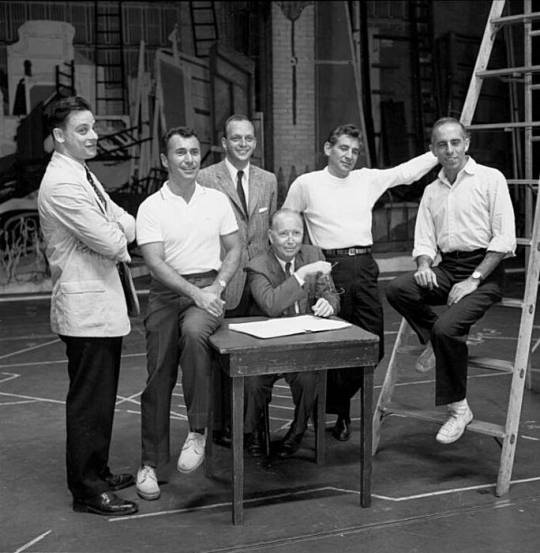
8 JULY 1957
New York, NY
Rehearsals begin.

20 AUGUST 1957
Washington D.C.
West Side Story opens in Washington D.C.

26 SEPTEMBER 1957
New York, NY
West Side Story opens on Broadway at the Winter Garden Theatre, runs for 732 performances.

1957
Original Broadway Cast Recording

13 APRIL 1958
Tony Awards
Best Choreographer (Jerome Robbins)
Best Scenic Designer (Oliver Smith)

18 OCTOBER 1961
United Artists motion picture released:
Directed by Robert Wise and Jerome Robbins
Starring Natalie Wood, Richard Beymer, Russ Tamblyn, Rita Moreno, and George Chakiris

1961
Film Soundtrack Recording

Reviews and Articles of West Side Story
THE NEW YORK TIMES
27 September 1957
Theatre: "West Side Story," The Jungles of the City
By BROOKS ATKINSON
Although the material is horrifying, the workmanship is admirable.
Gang warfare is the material of "West Side Story," which opened at the Winter Garden last evening, and very little of the hideousness has been left out. But the author, composer and ballet designer are creative artists. Pooling imagination and virtuosity, they have written a profoundly moving show that is as ugly as the city jungles and also pathetic, tender and forgiving.
Arthur Laurents has written the story of two hostile teen-age gangs fighting for supremacy amid the tenement houses, corner stores and bridges of the West Side. The story is a powerful one, partly, no doubt, because Mr. Laurents has deliberately given it the shape of "Romeo and Juliet." In the design of "West Side Story" he has powerful allies. Leonard Bernstein has composed another one of his nervous, flaring scores that capture the shrill beat of life in the streets. And Jerome Robbins, who has directed the production, is also its choreographer.
Since the characters are kids of the streets, their speech is curt and jeering. Mr. Laurents has provided the raw material of a tragedy that occurs because none of the young people involved understands what is happening to them. And his contribution is the essential one. But it is Mr. Bernstein and Mr. Robbins who orchestrate it. Using music and movement they have given Mr. Laurents' story passion and depth and some glimpses of unattainable glory. They have pitched into it with personal conviction as well as the skill of accomplished craftsmen.
In its early scenes of gang skirmishes, "West Side Story" is facile and a little forbidding -- the shrill music and the taut dancing movement being harsh and sinister. But once Tony of the Jets gang sees Maria of the Sharks gang, the magic of an immortal story takes hold. As Tony, Larry Kert is perfectly cast, plain in speech and manner; and as Maria, Carol Lawrence, maidenly soft and glowing, is perfectly cast also. Their balcony scene on the firescape of a dreary tenement is tender and affecting. From that moment on, "West Side Story" is an incandescent piece of work that finds odd bits of beauty amid the rubbish of the streets.
Everything in "West Side Story," is of a piece. Everything contributes to the total impression of wildness, ecstasy and anguish. The astringent score has moments of tranquility and rapture, and occasionally a touch of sardonic humor. And the ballets convey the things that Mr. Laurents is inhibited from saying because the characters are so inarticulate. The hostility and suspicion between the gangs, the glory of the nuptials, the terror of the rumble, the devastating climax -- Mr. Robbins has found the patterns of movement that express these parts of the story.
Most of the characters, in fact, are dancers with some images of personality lifted out of the whirlwind -- characters sketched on the wing. Like everything also in "West Side Story," they are admirable. Chita Rivera in a part equivalent to the nurse in the Shakespeare play; Ken Le Roy as leader of The Sharks; Mickey Calin as leader of The Jets; Lee Becker as a hobbledehoy girl in one gang -- give terse and vigorous performances.
Everything in "West Side Story" blends -- the scenery by Oliver Smith, the costumes by Irene Sharaff, the lighting by Jean Rosenthal. For this is one of those occasions when theatre people, engrossed in an original project, are all in top form. The subject is not beautiful. But what "West Side Story" draws out of it is beautiful. For it has a searching point of view.
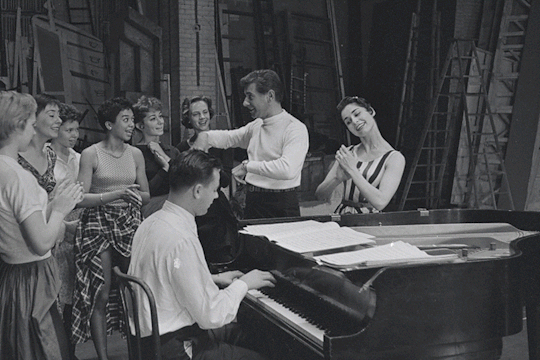
THE DAILY NEWS
27 September 1957
(Originally published by the Daily News on September 27, 1957. This story was written by John Chapman.)
‘West Side Story’ premieres on Broadway in 1957
BY JOHN CHAPMAN
The American theatre took a venturesome forward step when the firm of Griffith & Prince presented "West Side Story" at the Winter Garden last evening.
This is a bold new kind of musical theatre - a juke-box Manhattan opera. It is, to me, extraordinarily exciting. In it, the various fine skills of show business are put to new tests, and as a result a different kind of musical has emerged.
The story is, roughly, Shakespeare's recounting of the love and deaths of Romeo and Juliet. But the setting is today's Manhattan, and the manner of telling the story is a provocative and artful blend of music, dance and plot - and the music and the dancing are superb.
Superb Score
In this present-day version of the theatre's greatest romance, the Montagus and Capulets become young New York gangs, one white, the other Puerto Rican. The Romeo is a white boy, the Juliet a Puerto Rican girl. In the big fight switch-blade knives are used instead of swords. The apothecary who gave Romeo his fateful potion now is a mild druggist who mans his soda fountain and wonders what the younger generation is coming to. And the younger generation, even if it does indulge in one rumble which results in murder, is not nearly as blackhearted as current news stories might make us believe.
The music of "West Side Story" is by Leonard Bernstein, and it is superb - and splendidly played by an orchestra directed by Max Goberman. In it there is the drive, the bounce, the restlessness and the sweetness of our town. It takes up the American musical idiom where it was left when George Gershwin died. It is fascinatingly tricky and melodically beguiling, and it marks the progression of admirable composer.
The story, about the fundamentally innocent hoodlums of our town, is by Arthur Laurents, and it is a lovely and moving one. But Laurents is not alone in telling this story, for his collaborator is Jerome Robbins, the choreographer. Robbins and his superb young dancers carry the plot as much as the spoken words and lyrics do.
The lyrics, by Stephen Sondheim, have simple grace, and there is a lovely tribute by the sidewalk Romeo to his dusky girl, Maria. There is a really beautiful scene in which the boy and the girl go through a make believe wedding in a shop for bridal clothing. And there is an uproariously funny one in which a so-called juvenile delinquent gets a going-over by all the authorities whose problem he is - the cop, the judge, the social worker and the psychiatrist. This young hoodlum manages to make his elders look pretty silly.
Wonderful Cast
The cast of "West Side Story" is, next to the music, the best part of the production. It is composed of young people of whom few have been heard. Carol Lawrence and Larry Kert carry the love story with effortless simplicity, and they sing beautifully. There are other engaging performances by Chita Rivera, Mickey Calin, Ken Le Roy and Art Smith (the druggist). But the company itself is the star of the show. These boys and girls sing, dance and act with such skill and sincerity that they bring the audience out of its seats and up on the stage with them - and the stage is not a stage but this fascinating and fearful town of Manhattan.
And the settings by Oliver Smith and the costumes by Irene Sharaff are a perfect part of a perfect production.

NEW YORK HERALD TRIBUNE
27 September 1957
New York Herald Tribune, 9/27/57
Theater critic Walter Kerr wrote the following review of West Side Story for the New York Herald Tribune on September 27, 1957:
The radioactive fallout from "West Side Story" must still be descending on Broadway this morning.
Director, choreographer, and idea-man Jerome Robbins has put together, and then blasted apart, the most savage, restless, electrifying dance patterns we've been exposed to in a dozen seasons.
The curtain rises on a silence, and a pause. It is the last silence and the last pause. Against an empty-eyed background of warehouse windows five or six blue-jacketed young delinquents, with the tribal-mark "Jets" scrawled across their taut shoulders, are lounging, waiting for the first faint whisper of violence.
Their impatience comes to life in their fingers. A snapping rhythm begins to tap out a warning of mayhem to come. Knees begin to itch, and move, under the lazy, overcast mid-summer sky in Puerto-Rican New York.
The Sharks--equally young, equally sick with very old hatreds--appear from the alleyways in twos and threes. There is a sneer, a hiss, a tempting and tantalizing thrust of an arm, and then--with a powerhouse downbeat from the orchestra pit--the sorry and meaningless frenzy is on. From this moment the show rides with a catastrophic roar over the spider-web fire-escapes, the shadowed trestles, and the plain dirt battlegrounds of a big city feud.
Mr. Robbins never runs out of his original explosive life-force. Though the essential images are always the same--two spitting groups of people advancing with bared teeth and clawed fists upon one another--there is fresh excitement in the next debacle, and the next. When a gang leader advises his cohorts to play it "Cool," the intolerable tension between and effort at control and the instinctive drives of these potential killers is stingingly graphic. When the knives come out, and bodies begin to fly wildly through space under buttermilk clouds, the sheer visual excitement is breathtaking.
.[Robbins] has almost sacrificially assisted in this macabre and murderous onslaught of movement by composer Leonard Bernstein. Mr. Bernstein has permitted himself a few moments of graceful, lingering melody: in a yearning "Maria," in the hushed falling line of "Tonight," in the wistful declaration of "I Have a Love."
But for the most part he has served the needs of the onstage threshing machine, setting the fierce beat that fuses a gymnasium dance, putting a mocking insistence behind taunts at a policeman, dramatizing the footwork rather than lifting emotions into song. When hero Larry Kert is stomping out the visionary insistence of "Something's Coming" both music and tumultuous story are given their due. Otherwise it's the danced narrative that takes urgent precedence.

A Clip of a full description of the film and the actors thought on the film:
youtube
14 notes
·
View notes
Text
Altria Group (MO) Yearly Meeting Of Investors Event (Transcript).
I heard the peninsula get there on his souped up motorcycle. My concern is victor-strenghtbody.info exactly what shoudl I make use of to kill these grass and defend our yard, If you like I can easily deliver you my yard photos, and I made use of to take and dig out pots however its a lot of I spend 2 times still not end up. I only must have the capacity to air vent to her in some cases without her going nuts." Without a doubt, overwhelmingly, just what I learn through young people is actually that they are actually certainly not seeming corrected, but instead they frantically intend to feel heard and also recognized.
I possess an astigmatism in my appropriate eye, my eye was actually slightly cocked outside and the little bone tissue around that ideal eyeball placed stress onto my eye, giving me puncturing discomfort within this. I also had to hold my lower mandible back my whole lifestyle to create pearly whites match, resulted in clenching over night, problems in the morning from the evening long squeezing and at some point wound up with TMJ and also Lock-jaw.
I do not place any blame on some of the youngsters within this incident-- something an amount of the assessments have actually blatantly done-- given that they're kids that are actually dealing with their own crap as well as they don't know how to not predict that over folks.
I organize my brand new life as a grownup like some individuals plan for the apocalypse. Guaranteeing your personal little ones do not grow sensation dismissed or even disregarded prevails. I resided in te worst pain of my lifestyle my whole face and also back were actually puffy as well as I didn't recover till the complying with time.
When lifestyle improvements occur-including a brand new sibling, starting or altering colleges, fatality from a loved one or perhaps the add-on from a brand new pet-children might present bad habits. Being extremely crucial and Your Interior Youngster: Some people are actually overly critical because this is actually only exactly how they were actually handled as youngsters.
. The goal, of course, is close and also hot relationships along with your individual adult little ones, probably as you had along with your parents (or desire you had possessed along with your parents.) And also there are some adolescent youngsters who are genuinely splendid concerning maintaining cozy as well as near ties along with their parents.
He doesn't rely on that I am making an effort really extremely challenging to become the very best mother I can for my personal kids which their needs have to happen just before his. Nevertheless, ACODS might discover themselves in a lot of predicaments that younger children are actually exempted, such as becoming aware of their parents' dating life.
Suppliers from vitamin B-100, a nutritional supplement which contains a minimum of ONE HUNDRED milligrams, 100 micrograms or One Hundred Percent from the advised dietary allowance of each B vitamin, assert their products could provide you with the nutrients you need to have for far better health and wellness and also even more power.
Harvey Hornstein, Brutal Managers as well as Their Target: How to Determine and also Get Rid Of Misuse in the Office (1996)-- This job by a social psychologist reviews poor supervisor habits, with specifically applicable investigation lookings for as well as discourse concerning abusive supervision in the midst of tough economical times.
This was actually yet another solid fourth along with above market development, 15.1% development as well as 7.5 when you leave out Actelion achievement. Wonderful staff members that engaged & took time out - now and then analysis, dancing & chatting to my little ones. If signs do not enhance within three times from beginning the antibiotic, clients need to tell their doctor.
0 notes